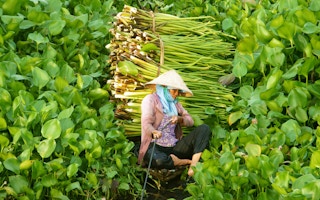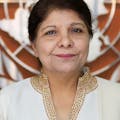Change is in the air: today women have better access to education, health services and jobs, as well as a greater voice in parliaments. Progress, however, in women’s empowerment has been slow and uneven. Growth and development gains have not been shared equally, both across the globe and within regions, with development gaps wider for poor and ethnic groups and those at the lower end of the income strata.
To continue reading, subscribe to Eco‑Business.
There's something for everyone. We offer a range of subscription plans.
- Access our stories and receive our Insights Weekly newsletter with the free EB Member plan.
- Unlock unlimited access to our content and archive with EB Circle.
- Publish your content with EB Premium.
Violence, conflicts and climate adversities have disproportionately impacted women, magnifying gender injustice and vulnerabilities.
Greater integration of women in the labour market – at all levels and in all sectors – is key to equitable, inclusive and sustainable development and is a legitimate right of women. Even though women constitute 50 per cent of Asia-Pacific’s total working age population, their participation in formal employment is uniformly lower than that of men. In many countries in the region, the national female employment-to-population ratios are below 50 per cent, which is not the case for men.
And in some countries, the female employment-to-population ratio drops below 30 per cent. Moreover, the contribution of women to the economies of Asia and the Pacific, through household and informal sector labour, is recognized but unrecorded in the national accounts.
Gender-based discrimination is pervasive and goes beyond labour force participation, as social and cultural taboos perpetuate discriminatory and restrictive traditional gender roles in different aspects of women’s and men’s lives. There is a cost to gender discrimination and inequality. UN estimates reveal that low participation by Asia-Pacific women in the labour market bears an opportunity cost of more than $89 billion each year.
In South Asia and Central Asia, for example, the lower employment rates of women result in an average national income loss of nearly 19 per cent and 16 per cent, respectively. A World Bank analysis illustrates that if women’s economic activity were on par with men’s, economic growth in many Asia-Pacific countries could increase by as much as 18 per cent.
Equally disconcerting are trends in key Asia-Pacific social indicators. For instance, the region accounts for close to 40 per cent of the world’s maternal deaths, up to 70 per cent of women experience violence during their lifetimes, female literacy levels in some pockets of South and South West Asia are below 50 per cent, and women’s participation in national legislatures is, in too many instances, below 10 per cent.
2015 marks the 20th anniversary of the adoption of the Beijing Declaration and Platform for Action, which is the global agenda for achieving gender equality and advancing the status of women and girls. As part of the 20-year review, Governments in Asia and the Pacific have identified women’s economic empowerment, political participation and the elimination of violence as fundamental to our future, and a priority for achieving gender equality in the region.
“
Violence, conflicts and climate adversities have disproportionately impacted women, magnifying gender injustice and vulnerabilities. Greater integration of women in the labour market – at all levels and in all sectors – is key to equitable, inclusive and sustainable development and is a legitimate right of women.
Policy makers, undoubtedly, need to wrestle with a host of issues in order for women and men, girls and boys, to have equal opportunities, to fully and freely exercise their rights and to be able to exercise choice and self-determination, without being discriminated against on the basis of their sex.
Strategic measures for enhancing women’s economic empowerment range from strengthening and enforcing legislation to initiatives that promote decent work and work-life balance for both women and men by, among other measures, broadening the base of financial inclusion and delivering targeted programmes and services that improve social indicators.
At the “Asian and Pacific Conference on Gender Equality and Women’s Empowerment: Beijing+20 Review”, ministers and other policy-makers from across the region will have the opportunity to renew their political commitment to empower women and advance their status in all sectors.
Integral to the discussions will be adopting, strengthening and enforcing policies and legislation that mandate equality of rights and opportunities for women and men.
Measures for addressing the elimination of violence against women, promoting women’s leadership and political participation, mainstreaming gender across the government sector (including gender-responsive budgeting), and advancing effective and coordinated institutional mechanisms for greater gender equality are just some of the specific issues that will be addressed in Bangkok.
Providing an impetus to the debate, the G20, which includes eight countries from the Asia-Pacific region, has called for reducing the gap between female and male labour force participation in their countries by 25 per cent. Realization of this goal by 2025 – no small feat – would add 100 million more women to the labour force.
Asia and the Pacific could lead the way in this area. Facilitating women’s integration in formal employment, governments and the private sector need to, for instance, embrace flexible working hours and telework; tailor tax systems based on personal income (rather than family incomes); and provide high-quality affordable child and elderly care services. Such measures reflect a growing global and regional commitment to increasing the rates and quality of women’s participation in the workforce.
Equally important is challenging the underlying stereotypes and assumptions about childbearing, parenting and the roles of women and men in the home and in the workplace. In particular, the needs and interests of vulnerable groups of women workers – such as domestic workers, migrant workers, informal sector workers and rural workers – need to be addressed. Traditional gender roles that confine women to caring, cashiering, cleaning, catering and clerical work must be revisited, if the ‘glass ceiling’ is ever to be fully dismantled and the ‘sticky floor’ cleaned.
Significant and substantive gains for women’s economic empowerment, and for gender equality more generally, require more resources, greater accountability, stronger partnerships and institutions, and better regional cooperation. The Asia-Pacific Beijing+20 Conference offers a valuable opportunity for our region to celebrate women and to recognize their value, both as a matter of human rights and for our shared prosperity.
Shamsad Akhtar is an Under-Secretary-General of the United Nations and Executive Secretary of the Economic and Social Commission for Asia and the Pacific (ESCAP). She is also the UN’s Sherpa for the G20 and previously served as Governor of the Central Bank of Pakistan and Vice President of the MENA Region of the World Bank.











